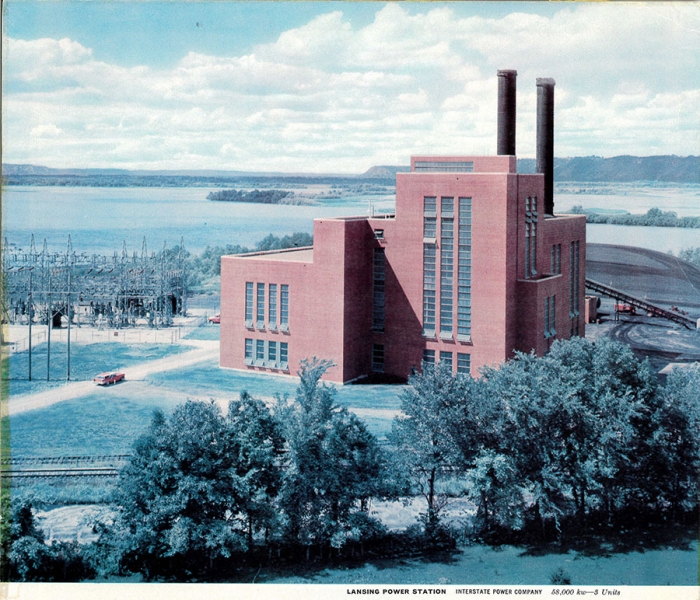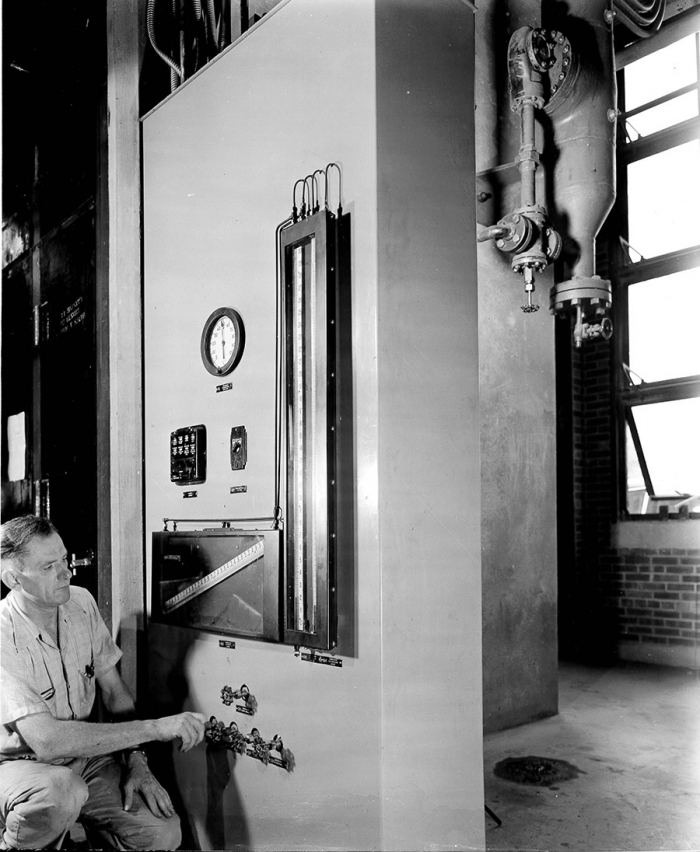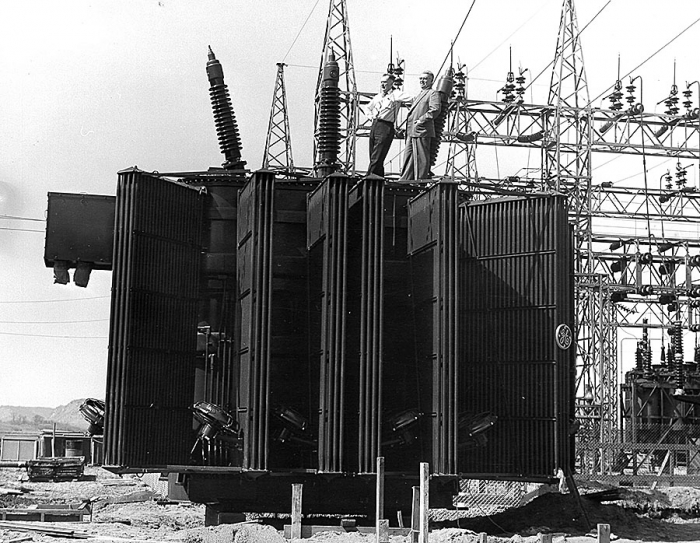You are here
Home ›Ladies whose fathers were early employees at the Lansing Generating Station reflect on memories as facility nears closure at end of this year

The photo above shows a general view of the Lansing Generating Station in the late 1950s after completion of the third production unit in 1957. Unit #1 of the facility began serving the area in 1948 with 15 megawatts of power; Unit #2 began later in 1948 and offered11.5 megawatts; and Unit #3 was put into production in 1957 with 37.5 megawatts of power. All three of those original units were retired out of production over a span of seven years from 2006 through 2013. Unit #4, which has been in operation since 1977 and has produced 257 megawatts of power, is the final unit operating today and will be retired as this year comes to a close and the facility is taken completely out of production. Photo courtesy of Shirley (Hoksch) Boardman, daughter of Orville Hoksch, the first plant manager for the Lansing Generating Station.

Pictured above is Orville Hoksch, the first plant manager for the Lansing Generating Station, making adjustments to the hydrogen control panel and detraining tank during the plant’s early operation days in 1948. Photo courtesy of Shirley (Hoksch) Boardman, daughter of Orville Hoksch, the first plant manager for the Lansing Generating Station.

Pictured above surveying the construction of Unit #3 of the Lansing Generating Station in May of 1956 atop one of the instrumental pieces of that new facility are the Lansing Generating Station’s first manager Orville Hoksch (at left in shirt and tie) and a member of the Interstate Power Company management team, Ken Gallagher (at right in suit). Interstate Power Company originally built the Lansing Generating Station before merging with two other power companies in 1999 to become Alliant Energy. Photo courtesy of Shirley (Hoksch) Boardman, daughter of Orville Hoksch, the first plant manager for the Lansing Generating Station.
A tall tower serving the Lansing Power Plant has been a part of the southern Lansing skyscape for 74 years. Within the next two years it will be gone, only to be remembered by those who lived here during the years of its operation. Although many have benefited from the energy the plant created, some area residents have special memories of the plant because of personal connections. Currently of Cincinnati, OH, Shirley Boardman shared pictures of the early power plant and a story about her father, who was the first manager of the plant in 1948: “My father was Orville Hoksch. He began working in power plants in Bismarck, ND, and then in Harvey, ND. Our next move was to Albert Lea, MN where he was the chief engineer/manager of the plant there. From there we moved to Lansing in 1948 where he was to be the chief engineer/manager of the plant that was being built there. “These were pre-OSHA times, so I and my two older brothers, Jim and Orville Jr., were allowed to come to the power plant and spend the day with dad. I never came with my brothers, so I’m not sure what they did at the plant. I sometimes brought another friend with me. I remember that I could go anywhere in the plant that I wanted. “Occasionally, the river would flood, and the road on the south end of town would be covered with water. Dad would have to park his company truck on the Lansing side, get in a boat that had been left there for him, and row across the flooded area (close to where the Driftless Center is now) where another vehicle was parked for him to drive to the plant. Coming home was just a reverse process.” Lansing resident Shirley Darling also shared memories of the early plant. Her father worked at the plant for many years: “My memories of Interstate Power Company (IPC) go back to my early childhood. I was born in Lansing November 12, 1940, a few years before construction of the power plant. My dad, Ray Fink, worked as a heavy equipment operator and crew supervisor on the construction of the Alaska Highway in 1942-1943 during WWII. One of the highway contractors he worked for was a company named Bates & Rogers. “When plans for the new IPC (Interstate Power Company) plant at Lansing were finalized, Bates & Rogers was awarded the construction contract and work began a few years after the war’s end. Dad was hired by his old bosses at Bates & Rogers to work on building the power plant. When construction of the plant was completed and IPC was ready to go online, they needed to hire someone who could not only operate a crane to unload coal from the barges, but who could also operate a caterpillar/scraper to maintain the coal pile. IPC hired Dad and Dad recommended his good friend, Ben Irons, who was also a skilled heavy equipment operator, for the second position. Dad and Ben rotated between the two jobs for several years. “The barge-unloading crane was not totally enclosed and the cat and scraper were not enclosed at all. The original building plans did not include showers for the employees, and I remember my dad coming home from work almost totally covered in coal dust, the whites of his eyes in total contrast to the rest of him. We lived with my maternal grandfather, Gus Laabs, in south Lansing and did not have indoor plumbing. The City of Lansing did not run sewer/water lines to south Lansing until 1948 so, like many of our fellow south town residents, we had outdoor plumbing. Our water supply came from a spring house my grandfather built in the 1920s. “Dad put a bathroom down in the cellar as soon as access to the sewer became available. Now, I wonder how my mother got his work clothes clean, or how Dad was able to keep his body clean. Ben Iron’s children also have memories of their dad coming home covered in coal dust. “The ‘bunkers’ had to be kept full of coal, so some Sunday mornings it was my dad’s turn to fill them. Sometimes he would take me and my younger brother, Jack, along with him and we would play around the building while Dad worked. Once, Dad gave us a ‘tour’ of the inside of the building which included a trip to the roof top where we could look out over the river. The stairs we had to climb were grated and we could look down through them as we ascended to the top floor and out onto the roof. It was scary and a little disorienting being able to look down through the stairs, but the view from the rooftop was worth the climb. I remember thinking this must be what the top of the world looks like. “There were flowers planted in beds bordering the sidewalk on the river side of the building. I remember marigolds and petunias. Diana Hurley, a Lansing girl, was the first power plant secretary and she may have tended the flower beds. During those first years, the barge-unloading crane was on a sort of pedestal out in the river with access to it being a plank walkway from shore to the crane. There were no railings for the crane operator to hang onto as he traversed back and forth from the crane. I remember ‘walking the planks’ with Dad a time or two and being more than a little afraid. OSHA must have been a distant dream in those days. “The County road that travels past the power plant was a gravel road and the land on the hillside was all pasture. The homes gracing the hill with the beautiful river views didn’t exist. There was no housing development there for years. “The first plant manager was Orville Hoksch and he held that position through at least one expansion project, and possibly two. Orville, his wife, Ann, and their four children, Orville, Jr., Jim, Shirley and Bob, lived in the big white house on the southeast corner of Dodge and 5th Streets. There was an IPC office uptown on the north corner of 4th and Main in the building and space now occupied by Studio K beauty salon. That’s where everyone went to pay their light bills and look over the latest in Westinghouse electric appliances – stoves, washers, dryers, water heaters, etc. Patrons were able to purchase an appliance on the monthly payment plan with the payment being added to their light bills. “The first office girl I remember was Ruth Reed. When she married and left her position, Veronica Wendler filled Ruth’s spot. Charles Smith was the meter reader and lineman. As I recall, Lansing’s plant was a part of the Decorah district, and a Mr. Lyshoj was the district manager. Dad always spoke highly of Mr. Lyshoj. “In those early years, employee’s children under the age of 12 received a Christmas present. The present I recall vividly was a pen with a transparent tube containing a miniature Rudolph, the Red-Nosed Reindeer that rose up and down in the tube when the pen was flipped. That pen was so special to me because it was gifted around the same time the song by the same name, and sung by my favorite singing cowboy, Gene Autry, was recorded. Other special occasions were the summertime picnics IPC held for employees and their families at Phelps Park in Decorah. As the company grew, both the Christmas gifts and picnics ceased. “IPC noted and promoted safety on the job. For many, many years the Lansing plant held the record for no lost time due to injuries in the workplace, a statistic that was lauded and applauded at annual company meetings over and over again. Dad related how proud they (employees) all were of their record and each one dreaded the possibility of being the first to break the record. Eventually, the record was broken but I don’t recall who the unfortunate employee was who broke it. “A very visible symbol for IPC was ‘Reddy Kilowatt’. Reddy was a little man in the form of a lightning bolt, had a light bulb for a nose and was, as his name suggests, the color red. He was present in a lot of IPC’s advertising, and I remember my dad sporting a Reddy Kilowatt tie tack. “The first addition/expansion project I recall was around 1955-56, when I was a sophomore in high school. Well before that time, my dad had taken a job inside the plant as assistant operator and left his days of unloading/moving coal from the barges. Plant operators and assistant operators worked three rotating shift periods and the place was staffed 24/7. Manager of the expansion project was Mr. Ken Shaw. His daughter, Shirley, joined my sophomore class that school year at Lansing Public School. “As the plant grew, so did the need for more employees. Showers for the employees were added and they were able to get clean of the constant coal dust before leaving work for home. IPC was a big presence in our community/county/area. It employed a lot of workers, paid lots of property taxes and cast a big shadow. “The last big expansion project came in the early 1970s. By that time, Orville Hoksch had retired, and Earl Benson transferred in from another IPC plant and took over the role of Plant Manager in Lansing. Fegeles Power Service (FPS) was awarded the contract, and, to my happy surprise, the project manager was the same Mr. Ken Shaw who directed the first expansion in the 1950s. Projects like those always meant an influx of non-local employees and a big boost for local businesses - grocery stores, gas stations, rental units, etc. Both my husband, Brent, and I were among those employed by FPS, Brent as a millwright and I joined the office staff. My dad was still an active employee of IPC. Not too long after the project was complete, my dad was ready for retirement. “IPC had an anti-nepotism policy that caused my dad some frustration. IPC, like many other employers, hired part-time help every summer, mostly young high school age boys. I had three older brothers, none of whom could get hired on at IPC because Dad worked there. That frustration grew as the latest expansion project was completed and IPC was hiring more, new workers. Brent, my husband, couldn’t apply because Dad was still working there. So, when Dad informed Earl Benson of his plan to retire, Brent got a phone call from Earl asking if he was interested in working in maintenance at the plant. The whole employment cycle had come full circle. My dad was hired because the original contractors, Bates & Rogers, had personal experience and knowledge of Dad’s work skills. Now, my husband was hired because plant manager Earl Benson had personal experience and knowledge of Brent’s work skills. “Somewhere along the line the anti-nepotism policy relaxed because our daughter, Sheryl, was employed for a summer between her college years and rode to work each day with her dad. She came home covered in coal dust just as her grandfather, Ray Fink, had so many years before. Sheryl was the third-generation member of my family to be employed at the power plant. Also, at some point the powers-that-be decided the office on Main Street in Lansing was no longer needed. There are no more company picnics, and the memory of a Christmas gift as a young child of an employee is extremely distant. “Interstate Power Company became Alliant Energy and the years rolled on. Brent retired from Alliant in 2002 - well before the decision to close the plant was made. I have many good memories associated with IPC/Alliant and am so sad the power plant here will no longer be.”

